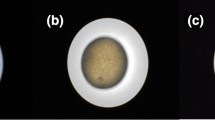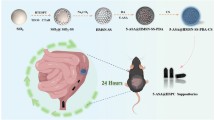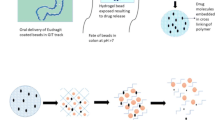Abstract
The necessity of colon-specific drug delivery systems has been well recognized. Porous silica (PSi) coated with a pH-sensitive, biocompatible, and biodegradable polymer can be useful in colon delivery. In this study, porous silica was synthesized and sulfasalazine was loaded into it to investigate the release rate in a simulated intestinal media. The media was kept at 37 °C and pH 6.8 and 7.4, and subjected to continuous ultrasonic waves to simulate body fluid flow. Aqueous alginate and N, O-Carboxymethyl chitosan (NOCC) solutions, with a distinct composition (3% W/V) in different ratios, were prepared and coated on pressed porous silica disks. Porous silica (PSi) was also functionalized by aminopropyltrimethoxysilane grafting and was studied as a potential carrier for the controlled drug release of sulfasalazine. The release was studied in simulated gastric and intestinal media and results show that no burst release occurred in both coated and functionalized samples and the swelling degree of coats at basic and neutral media decreased by the presence of alginate in the network. It is concluded that the coat with a 50:50 ratio can release the colon drugs in 24 h at a suitable rate. It is also envisioned that functionalization was a factor boosting drug uptake, however, the release rate was lower in the functionalized samples. This study opens the gates to new ideas for the potential safe and localized delivery of sulfasalazine.








Similar content being viewed by others
Data Availability
Not applicable.
References
Anitha, A., Sreeranganathan, M., Chennazhi, K. P., Lakshmanan, V. K., & Jayakumar, R. (2019). Corrigendum to “In vitro combinatorial anticancer effects of 5-fluorouracil and curcumin loaded N, O-carboxymethyl chitosan nanoparticles toward colon cancer and in vivo pharmacokinetic studies.” European Journal of Pharmaceutics and Biopharmaceutics, 139, 44–46.
Khang, Ch., Wang, X., Xiao, M., Ma, J., Qu, Y., Zou, L., & Zhang, J. (2022). Nano-in-micro alginate/chitosan hydrogel via electrospray technology for orally curcumin delivery to effectively alleviate ulcerative colitis. Materials & Design, 221, 110894.
Han, X., Alu, A., Liu, H., Shi, Y., Wei, X., Cai, L., & Wei, Y. (2022). Biomaterial-assisted biotherapy: A brief review of biomaterials used in drug delivery, vaccine development, gene therapy, and stem cell therapy. Bioactive Materials, 17, 29–48.
Assifaoui, A., Bouyer, F., Chambin, O., & Cayot, P. (2022). A drug delivery system based on poly-L-lysine grafted mesoporous silica nanoparticles for quercetin release. Colloids and Surfaces A: Physicochemical and Engineering, 648, 129343.
Newham, G., Mathew, R., Wurdak, H., Evans, S., & Ong, Z. (2021). Polyelectrolyte complex templated synthesis of monodisperse, sub-100 nm porous silica nanoparticles for cancer targeted and stimuli-responsive drug delivery. Journal of Colloid and Interface Science, 584, 669–683.
Hu, Y., Bai, S., Wu, X., Tan, S., & He, Y. (2021). Biodegradability of mesoporous silica nanoparticles. Ceramic International, 47, 31031–31041.
Hagman, E., Elimam, A., Kupferschmidt, N., Ekbom, K., Rössner, S., Iqbal, M., Johnston, E., Lindgren, M., Bengtsson, T., & Danielsson, P. (2020). Oral intake of mesoporous silica is safe and well tolerated in male humans. PLoS ONE, 15, e0240030.
Kumeria, T., McInnes, S. J. P., Maher, S., & Santos, A. (2017). silicon for drug delivery applications and theranostics: Recent advances, critical review, and perspectives. Expert Opinion on Drug Delivery, 14, 1407.
Hosseinpour, S., & Walsh, L. J. (2020). Chun Xu Biomedical application of mesoporous silica nanoparticles as delivery systems: A biological safety perspective,. Journal of Materials Chemistry B, 8, 9863–9876.
Li, Z., Mu, Y., Peng, C., Lavin, M. F., Shao, H., & Du, Z. (2021). Understanding the mechanisms of silica nanoparticles for nanomedicine. WIREs Nanomedicine and Nanobiotechnology, 13, e1658.
Ghazaie, M., Ghiaci, P., & Ghiaci, M. (2017). delivery systems Microporous and Mesoporous. Materials, 244, 291–300.
Ghasemiyeh, P., & Mohammadi-Samani, S. (2019). Hydrogels as drug delivery systems Pros and cons, trends in. Pharmaceutical Sciences, 5(1), 7–24.
Bulbake U, Doppalapudi S, Khan W. eds Ahmed S, Ikram S. Chitin – and chitosan‐based scaffolds. In Chitosan 2017.
Freag, M. S., Saleh, W. M., & Abdallah, O. Y. (2018). Exploiting polymer blending approach for fabrication of buccal chitosan-based composite sponges with augmented mucoadhesive characteristics. European Journal of Pharmaceutical Sciences, 120, 10–19.
Borgheti-Cardoso LN, Vicentini FT, Vicentini FT, Filho MS, Gelfuso GM. eds Thakur VK, Thakur MK, Kessler MR. Pharmaceutical delivery systems composed of chitosan. In Handbook of Composites from Renewable Materials 2017.
Khlibsuwan, R., & Pongjanyakul, T. (2018). Particle agglomeration of chitosan–magnesium aluminum silicate nanocomposites for direct compression tables. International Journal of Pharmaceutics, 535, 410–419.
Niaz, T., Sarkar, A., Mackie, A., & Imran, M. (2021). Impact of albumin corona on mucoadhesion and antimicrobial activity of carvacrol loaded chitosan nano-delivery systems under simulated gastro-intestinal conditions. International Journal of Biological Macromolecules, 19, 171–182.
Yin, T., Zhang, Y., Liu, Y., Chen, Q., & Huo, M. (2018). The efficiency and mechanism of N-octyl-O, N-carboxymethyl chitosan-based micelles to enhance the oral absorption of silybin. International Journal of Pharmaceutics, 536, 231–240.
Zargar, V., Asghari, M., & Dashti, A. (2015). A review on chitin and chitosan polymers: Structure, chemistry, solubility, derivatives, and applications. ChemBioEng Reviews, 2, 204–226.
Omer, A. M., Ahmed, M. S., El-Subruiti, G. M., Khalifa, R. E., & Eltaweil, A. S. (2021). pH-sensitive alginate/carboxymethyl chitosan/aminated chitosan microcapsules for efficient encapsulation and delivery of diclofenac sodium. Pharmaceutics, 13(3), 338.
Alba K, Kontogiorgos V. Seaweed Polysaccharides (Agar, Alginate Carrageenan) Encyclopedia. Reference Module in Food Science 2018.
Le, A., Nguyen, T., Ly, K., Luong, T., Ho, M., Tran, N., Dang, N., Vo, T., Tran, Q., & Nguyen, T. (2020). Modulating biodegradation and biocompatibility of in situ crosslinked hydrogel by the integration of alginate into N, O-carboxymethyl chitosan – aldehyde hyaluronic acid network. Polymer Degradation and Stability, 180, 109270.
She X, Chen L, Li C, He C, He L, Kong L, Functionalization of hollow mesoporous silica nanoparticles for improved 5-FU loading. Journal of Nanomaterials 2015, 872035.
Kwon, S., Singh, R. K., Perez, R. A., Neel, E. A. A., Kim, H. W., & Chrzanowski, W. (2013). Silica-based mesoporous nanoparticles for controlled drug delivery. Engineering, 4, 1.
Mladenovska, K., Dodov, M. G., & Goracinova, K. (2007). Colon-specific delivery of 5-aminosalicylic acid from chitosan-Ca-alginate microparticles. International Journal of Pharmaceutics, 342, 124–136.
Pérez-Sánchez, G., Gomes, J. R. B., & Jorge, M. (2013). Modeling self-assembly of silica/surfactant mesostructures in the templated synthesis of nanoporous solids. Langmuir, 29, 2387.
Chen, S. C., Wu, Y. C., Mi, F. L., Lin, Y. H., Yu, L. C., & Sung, H. W. (2004). A novel pH-sensitive hydrogel composed of N, O-carboxymethyl chitosan, and alginate cross-linked by genipin for protein drug delivery. Journal of Control Release, 96, 285–300.
Zhu, M., Liu, L., & Wang, Z. (2020). Mesoporous silica via self-assembly of nano zinc amino-tris-(methylene phosphonate) exhibiting reduced fire hazards and improved impact toughness in epoxy resin. Journal of Hazardous Materials, 392, 122343.
Huang Y, Yang J, Huaqiang Cai H, Zhai Y, Feng D, Deng Y, Tu B, Zhao D. A curing agent method to synthesize ordered mesoporous carbons from linear novolac phenolic resin polymers. Journal of Materials Chemistry 2009, 36. https://doi.org/10.1039/B908183F
Webber, R. E., & Shull, K. R. (2004). Strain dependence of the viscoelastic properties of alginate hydrogels. Macromolecules, 37, 6153–6160.
Shaheen, A., Maswal, M., & Dar, A. A. (2021). Synergistic effect of various metal ions on the mechanical, thixotropic, self-healing, swelling, and water retention properties of bimetallic hydrogels of alginate. Colloids and Surfaces A: Physicochemical and Engineering Aspects, 627, 12723.
Tapia, C., Escobar, Z., Costa, E., Sapag-Hagar, J., Valenzuela, F., Basualto, C., Gai, M. N., & Yazdani-Pedram, M. (2004). Comparative studies on polyelectrolyte complexes and mixtures of chitoalginate and chitosan-carrageenan as prolonged diltiazem clorhydrate release systems. European Journal of Pharmaceutics and Biopharmaceutics: Official Journal of Arbeitsgemeinschaft fur Pharmazeutische Verfahrenstechnik eV, 57, 65–75.
Datt, A., El-Maazawi, I., & Larsen, S. C. (2012). Aspirin loading and release from MCM-41 functionalized with aminopropyl groups via co-condensation or postsynthesis modification methods. Journal of Physical Chemistry C, 116, 8358.
Putz, A. M., Len, A., Ianăşi, C., Savii, C., & Almásy, L. (2016). Ultrasonic preparation of mesoporous silica using pyridinium ionic liquid. Korean Journal of Chemical Engineering, 33, 749–754.
Balas, F., & Manzano, M. (2006). Horcajada, Vallet-Regí M Confinement and controlled release of bisphosphonates on ordered mesoporous silica-based materials. Journal of American Chemistry Society, 128, 8116.
Funding
The first author received financial support from the Oregon State University (OSU) College of Engineering for the.
Author information
Authors and Affiliations
Contributions
All authors contributed to the study’s conception and design. Material preparation, data collection, and analysis were performed by Sakineh Abbasi, Somaye Ghaffari, and Naghi Safa. The first draft of the manuscript was written by Sakineh Abbasi and all authors commented on previous versions of the manuscript. All authors read and approved the final manuscript.
Corresponding author
Ethics declarations
Ethical Approval
Not applicable.
Consent to Participate
Not applicable.
Consent for publication
Not applicable.
Competing Interests
Surface biomodification of ceramic materials to control drug release rates is currently of interest to the authors.
Additional information
Publisher's Note
Springer Nature remains neutral with regard to jurisdictional claims in published maps and institutional affiliations.
Rights and permissions
Springer Nature or its licensor (e.g. a society or other partner) holds exclusive rights to this article under a publishing agreement with the author(s) or other rightsholder(s); author self-archiving of the accepted manuscript version of this article is solely governed by the terms of such publishing agreement and applicable law.
About this article
Cite this article
Abbasi, S., Ghaffari, S. & Safa, N. Porous Silica as Drug Carrier for Controlled Delivery of Sulfasalazine: The Effect of Alginate-N, O-Carboxymethyl Chitosan Gel Coating and Amine Functionalization. Appl Biochem Biotechnol 195, 3719–3732 (2023). https://doi.org/10.1007/s12010-022-04278-9
Accepted:
Published:
Issue Date:
DOI: https://doi.org/10.1007/s12010-022-04278-9




